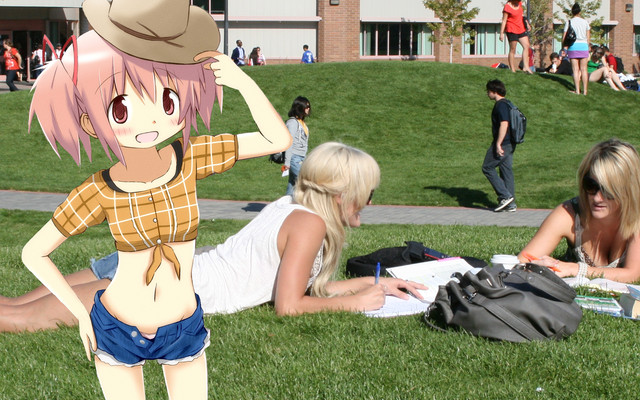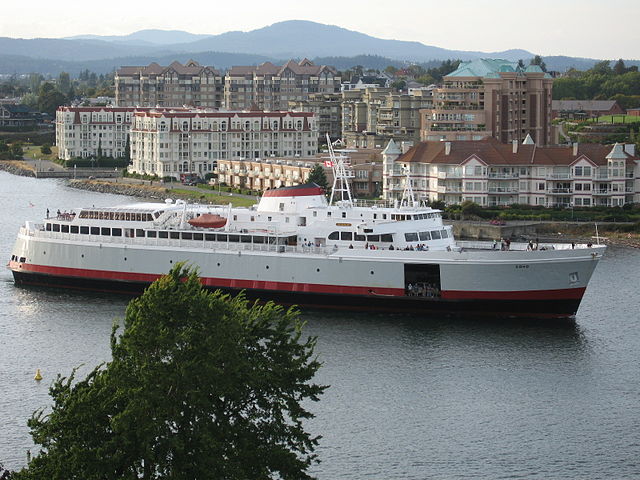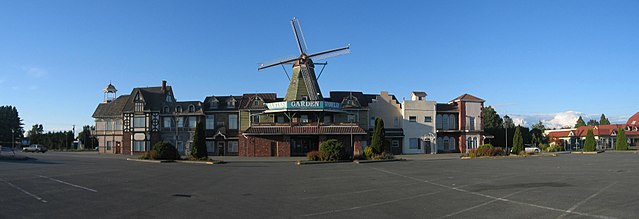
Mitakihara Homecoming 2062: Dream Skyward
By Konomi Fujimiya
The Daily Magi
September 25, 2062
This week, Mitakihara University is celebrating a time-honored tradition on campus: it's Homecoming Week. This year's theme is "Dream Skyward." Ikaruga Saito is this year's Homecoming Chair. She is a freshman Asian Studies major and is the daughter of Mitakihara University Chancellor Honoka Kaname.

"To Dream Skyward is to aim for the stars and look to the future and the promise it brings for today," said Saito at a promotional event at Madoka Square for Homecoming 2062 hosted by the MadokASI. "Our student must strike to aim higher and go beyond the limits, think outside the box.
"When students like myself can raise the standard rethink the ways we do things in this world, society can progress and improve. That's part of the mission that defines Mitakihara University and Homecoming this year salutes the ambition of dreaming skyward."
A number of events will take place leading up to the Homecoming Game against the Navy Midshipmen on September 30, 2062 at 12:30 p.m. PT/3:30 p.m. ET. The game will be televised by City, TVA Sports, ESPN, NHK and BBC.
The Schedule is as follows:
(all times in PT)
Tuesday, September 26
8:00 a.m. - Morning Prayers to Madoka - Madoka Chapel
Speaker: Archbishop Arthur Bendik
Roman Catholic Archdiocese of Indianapolis
12 p.m. - Homecoming Registration Opens - Kaname Hall (Administration Building)
Registered participants must check in here for their Passport and vouchers for the Saturday Homecoming Barbecue at Mitakihara Stadium Parking Lot.
All Day - Museums: Spend the afternoon visiting one of the Mitakihara Museums. Admission is free with your Homecoming Passport.
* Nissin Museum of Ramen, 10 a.m. to 5 p.m.
* Hayao Miyazaki Museum of Art 9 a.m. to 5 p.m., miyazaki.madoka.ca
* Mitakihara Museum of Puella Magi, 9 a.m. to 5 p.m.
-Museums open all day Wednesday, Thursday Friday and Saturday
Madoka Garden: Find your peace of mind visiting the Madoka Garden, located next to the Madoka Chapel. Admission is free with your Homecoming Passport. Open 6 a.m. to sunset, all week.
Libraries: Admission is free at the following locations with your Homecoming Passport:
* Yuuki Library, 9 a.m. to 7 p.m.
* Saito Library 9 a.m. to 5 p.m.
Special Exhibit at Saito Library: The Countdown to the Canadian Bicentennial. For more information, please visit the Saito Library website.
Libraries open all day Wednesday, Thursday, Friday and Saturday
1 p.m. Classes: Participants are invited to sit in on a variety of undergraduate classes:
Classes TBA, see University Web Site
2 p.m. and 3 p.m. - Mizuhashi Library Tours
Take a guided tour of the Mizuhashi Library at the Mitakihara School of Graduate Studies. Tours will meet at the reception area inside the front door and will leave at 2:00 p.m. and 3:00 p.m. Space on each tour is limited.
3 p.m. - Open band practice
Mitakihara Director of Bands, Dr. Alex Cochran-Pierce, holds a special band practice with members of the Marching Ultimates, the university's marching band.
3:30 p.m. Campus tours led by The Society
The Society/La Societe is the premiere student-run organization that is dedicated to serving the Mitakihara University community and is owned and operated by the Mitakihara Associated Students. Tours are conducted in English, French and Japanese.
1. Mitakihara General Tour
2. Beyond The Campus: Madoka Square, The Dorms and More
3. Touring the Madoka Garden: Something for Everybody
(also will take place on Wednesday, Thursday and Friday)
4:30 p.m. Campus tours led by The Society/La Societe
1. Mitakihara Athletic Facilities
2. Madoka Architecture: Always Bold, Always Beautiful - The Legacy
3. Madoka Garden Tea Ceremony (refreshments provided)
(also will take place on Wednesday, Thursday and Friday)
5 p.m. - Nonaka House Association's Postmeridie Lecture and Award
Honoring novelist Ben Dover, OC
Presentation of Award, Hozuki Ferrari, Vice-Chancellor of Mitakihara University, Tsukino Centre (Doors open at 4:30.)
Wednesday, September 27
9 a.m.- 3 p.m. - Homecoming Registration - Kaname Hall (Administration Building)
Registered participants must check in here for their Passport and vouchers for the Saturday Homecoming Barbecue at Mitakihara Stadium Parking Lot.
5 p.m. - Mitakihara University Glee Club Concert
Tickets required: $50 for adults, $35 for students and $30 for seniors. Tickets can be purchased directly through the Mitakihara Box Office by phone at (250) 4MADOKA or online at the box office website.
Thursday, September 28
9 a.m.- 3 p.m. - Homecoming Registration - Kaname Hall (Administration Building)
Registered participants must check in here for their Passport and vouchers for the Saturday Homecoming Barbecue at Mitakihara Stadium Parking Lot
7 p.m. - Mitakihara University Rugby vs. Zimbabwe Men's National Team
Battle for the Arrow Of Light, Sakura Bowl Stadium. Tickets required: $70 for adults, $50 for students and $30 for seniors. Tickets can be purchased directly through the Mitakihara Box Office by phone at (250) 4MADOKA or online at the box office website.
5 p.m. - Men's Water Polo vs. Air Force
The Amagami Campus Pool
7 p.m. - Men's Handball vs. Nebraska
Urobuchi Fieldhouse, Akagi Court
7:30 p.m. - Sprint Football vs. Cornell
Hakurei Centre
Friday, September 29
9 a.m.- 3 p.m. - Homecoming Registration - Kaname Hall (Administration Building)
Registered participants must check in here for their Passport and vouchers for the Saturday Homecoming Barbecue at Mitakihara Stadium Parking Lot.
5 p.m. - Women's Volleyball vs. British Columbia
Battle for the Cup of Life. Exhibition, Anderson Court, Marisa Kirisame Pyramid
Approx. 8 p.m. - Pep Rally at Anderson Court, Marisa Kirisame Pyramid
Following the Women's Volleyball game vs. British Columbia, the 2062 Mitakihara Magi Football Team will be introduced. Speeches by head coach Tatsuya Kaname, offensive team captain Ray Lyles, defensive team captain Jeremy Ogboshogo, athletic director Nagisa Momoe and university chancellor Honoka Kaname will be made.
9 p.m. - Evening activities
Visit the Inu Daruma Pub or your favorite restaurant at the Campus.
The Meeting: Special gathering for Roseluck Arrow Boosters and Men About Town at McGann's, cash bar @ 9:00 p.m.
Saturday, September 30
6:00 - 9:00 a.m. - Breakfast at the Dorms - Passport holders are invited to enjoy a hot breakfast at the dorm of their choice. Pay at the door (cash please), cost is $15 per person.
8 a.m. - Morning Prayers to Madoka - Madoka Chapel
Speaker: Cardinal Jeffrey Skobrev
Roman Cathoic Archdiocese of Minneapolis
7 a.m. to 7 p.m. - Homecoming Headquarters and Registration- Rei Ayanami Field
Registered participants must check in here for their Passport and vouchers for the Saturday Homecoming Barbecue at Mitakihara Stadium Parking Lot.
9:00 a.m. Men's Soccer vs. Cal State Northridge
Hirasawa Field
11 a.m. Women's field hockey vs. Stanford
Rei Ayanami Field
12:00 p.m. Women's Soccer vs. California
Hirasawa Field
10 a.m. to kickoff Pre-Game Tailgate at Athletics
Pack a picnic and set up a tailgate with your friends prior to the Mitakihara-Navy football game. The Madoka Tailgate Area will be located inside Stade Sakura Bowl Gate 10. Cars can park here for $40, payable on-side. Tailgate is permitted for 2 hours prior to kickoff and for one hour following the game.
12:30 p.m. Football Kick-Off
Cheer on the Mitakihara Magi as they take on the Navy Midshipmen. A block of tickets for Madoka Homecoming is currently reserved through the Mitakihara Athletic Ticket Office. Tickets are required and cost $30 each, children ages 12 and under are free. Tickets can be purchased directly through the Mitakihara Box Office by phone at (250) 4MADOKA or online at the box office website.
11:00 a.m. - 4th quarter - Homecoming Barbecue
Barbecue in the Stade Sakura Bowl Parking Lot, Gates 6-9. A voucher for the "Ika's BBQ Fan Zone" is included in your Homecoming registration price. Please be sure to check-in at the Homecoming registration desk to receive your meal ticket. Drinks will be sold separately on-site. A variety of family a children's activities will be offered in the "Fan Zone," including face painting, music, sports games, prizes and raffles.
5:00 p.m. Women's Ice Hockey vs. McGill
Battle for the Sis Puella Magica Cup. Exhibition game, MetroTech Shanarena
8:00 p.m. - A Galactic Symphony
Presented by the Mitakihara University Philharmonic (MadoPhil), Tsukino Centre.
Ticket Required: Regular: $50.00, $40.00, $30.00;
Students: $30.00, $25.00, $20.00; Seniors (65+): $25.00,
$20.00, $15.00.
Tickets can be purchased directly through the Mitakihara Box Office by phone at (250) 4MADOKA or online at the box office website.
Sunday, October 1
9:00 a.m. - Mitakihara 10K Run/Walk for Life
Get ready to put on your running or walking shoes and take a cruise around the different places on campus and in Mitakihara. The route starts at Magia Quad and will weave around the city before ending at Madoka Square. Registration is $70.00 ($40.00 for students with ID, $20 for seniors) at the Magia Quad tent from 6 a.m. to 8:30 a.m. All proceeds benefit the BC Cancer Foundation. Refreshments and medals will be provided at finish line.


















